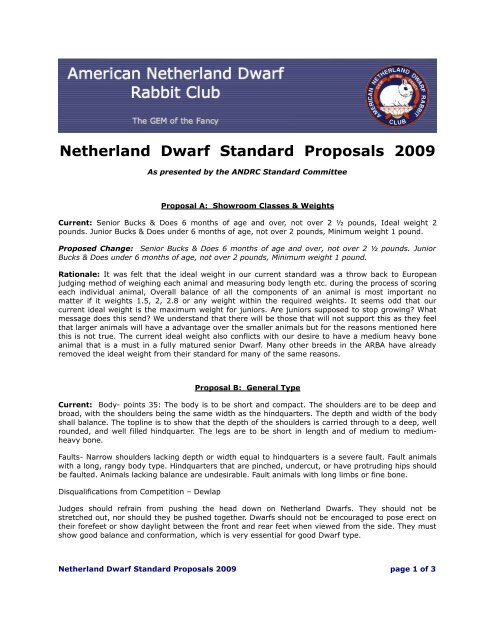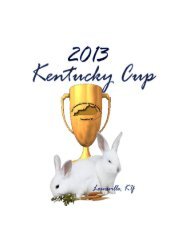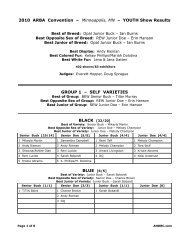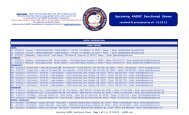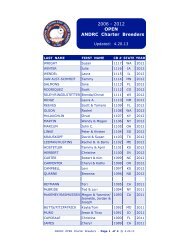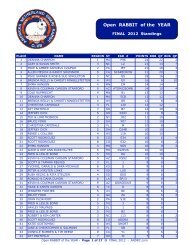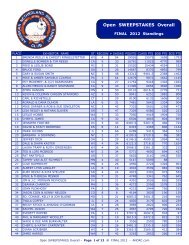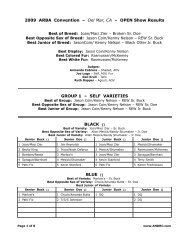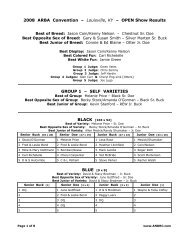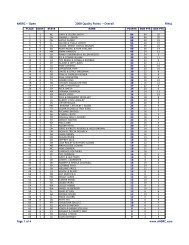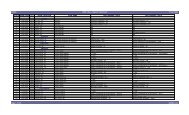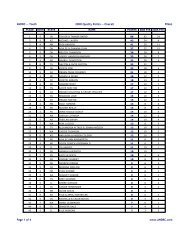NetherlandDwarfStandardProposals... - American Netherland Dwarf ...
NetherlandDwarfStandardProposals... - American Netherland Dwarf ...
NetherlandDwarfStandardProposals... - American Netherland Dwarf ...
Create successful ePaper yourself
Turn your PDF publications into a flip-book with our unique Google optimized e-Paper software.
<strong>Netherland</strong> <strong>Dwarf</strong> Standard Proposals 2009<br />
As presented by the ANDRC Standard Committee<br />
Proposal A: Showroom Classes & Weights<br />
Current: Senior Bucks & Does 6 months of age and over, not over 2 ½ pounds, Ideal weight 2<br />
pounds. Junior Bucks & Does under 6 months of age, not over 2 pounds, Minimum weight 1 pound.<br />
Proposed Change: Senior Bucks & Does 6 months of age and over, not over 2 ½ pounds. Junior<br />
Bucks & Does under 6 months of age, not over 2 pounds, Minimum weight 1 pound.<br />
Rationale: It was felt that the ideal weight in our current standard was a throw back to European<br />
judging method of weighing each animal and measuring body length etc. during the process of scoring<br />
each individual animal, Overall balance of all the components of an animal is most important no<br />
matter if it weights 1.5, 2, 2.8 or any weight within the required weights. It seems odd that our<br />
current ideal weight is the maximum weight for juniors. Are juniors supposed to stop growing? What<br />
message does this send? We understand that there will be those that will not support this as they feel<br />
that larger animals will have a advantage over the smaller animals but for the reasons mentioned here<br />
this is not true. The current ideal weight also conflicts with our desire to have a medium heavy bone<br />
animal that is a must in a fully matured senior <strong>Dwarf</strong>. Many other breeds in the ARBA have already<br />
removed the ideal weight from their standard for many of the same reasons.<br />
Proposal B: General Type<br />
Current: Body- points 35: The body is to be short and compact. The shoulders are to be deep and<br />
broad, with the shoulders being the same width as the hindquarters. The depth and width of the body<br />
shall balance. The topline is to show that the depth of the shoulders is carried through to a deep, well<br />
rounded, and well filled hindquarter. The legs are to be short in length and of medium to mediumheavy<br />
bone.<br />
Faults- Narrow shoulders lacking depth or width equal to hindquarters is a severe fault. Fault animals<br />
with a long, rangy body type. Hindquarters that are pinched, undercut, or have protruding hips should<br />
be faulted. Animals lacking balance are undesirable. Fault animals with long limbs or fine bone.<br />
Disqualifications from Competition – Dewlap<br />
Judges should refrain from pushing the head down on <strong>Netherland</strong> <strong>Dwarf</strong>s. They should not be<br />
stretched out, nor should they be pushed together. <strong>Dwarf</strong>s should not be encouraged to pose erect on<br />
their forefeet or show daylight between the front and rear feet when viewed from the side. They must<br />
show good balance and conformation, which is very essential for good <strong>Dwarf</strong> type.<br />
<strong>Netherland</strong> <strong>Dwarf</strong> Standard Proposals 2009 page 1 of 3
Proposed Change: Body- points 35: The body is to be short and compact, and well rounded. The<br />
shoulders are to be deep and wide. The shoulders and hindquarters are to be of equal width, showing<br />
no taper. The depth and width of body shall balance. The topline is to show that the depth of the<br />
shoulders is carried through to a deep well rounded and well filled hindquarters. The legs are to be<br />
short in length and of medium to medium-heavy bone.<br />
Faults- Weak shoulders lacking depth or width equal to the hindquarters. Fault animals showing length<br />
of body, lacking balance and roundness. Fault for lack of overall balance and uniformity. Fault animals<br />
that are pinched, undercut, or have protruding hips or animals with long limbs or fine bone.<br />
Disqualification from competition: Dewlap<br />
Judges should refrain from pushing the head down on <strong>Netherland</strong> <strong>Dwarf</strong>s. They should not be<br />
stretched out, nor should they be pushed together. <strong>Dwarf</strong>s should not be encouraged to pose erect on<br />
their fore feet or show daylight between the front and rear feet when viewed from the side.<br />
<strong>Netherland</strong> <strong>Dwarf</strong>s will pose more properly when handled gently. They must show good balance and<br />
conformation, which is essential for good <strong>Dwarf</strong> type.<br />
Reason for changes: Even with very little change here we thought the new and added wording is<br />
more clear and more descriptive for the General type section of the standard.<br />
Proposal C: Balance<br />
The Addition of a description of <strong>Netherland</strong> <strong>Dwarf</strong> balance to the Standard. To read as<br />
follows:<br />
The term balance is used to describe the ideal pleasing harmonious arrangement between the head,<br />
ears, body type, color, fur, and condition to achieve an animal that represents the short cobby, round,<br />
medium to medium-heavy boned rabbit our standard describes without predominance of any single<br />
feature. A well balanced animal is preferred over one which may excel in one aspect but is inferior in<br />
another.<br />
Reason for adding this section to the standard: The current standard does not describe or define<br />
what good <strong>Dwarf</strong> Balance should be. This will be a helpful addiction to our standard.<br />
Proposal D: Broken Variety<br />
Current: Disqualifications from Competition- The complete absence of color on the nose, around<br />
either eye, or on either ear. Eye color other than called for. Excessive scattered white hairs in colored<br />
section. (No disqualification for white spot(s) in colored section.) Color less than 10% or more than<br />
50%, in judge’s opinion.<br />
Change the current wording by adding: Disqualify any animal with the absence of color pattern in<br />
the form of spot(s) or blanket form on either or both sides of the body.<br />
Rationale: It was agreed that the lack of pattern on either or both sides of the body needed to be<br />
changed to a disqualification instead of just a fault to help perfect the Broken variety now instead of<br />
waiting another five years when the ARBA standard will be updated. Addressing this problem in the<br />
variety now is important to perfect them. This change will improve the appearance of Brokens that are<br />
being shown and help to create a better differential between animals that are at the 10% minimum<br />
color requirement.<br />
<strong>Netherland</strong> <strong>Dwarf</strong> Standard Proposals 2009 page 2 of 3
Current: Eyes — Blue-gray.<br />
Proposal E: Lynx Variety<br />
Proposed Change: Add to the eye section of the standard that the Lynx variety may also show a<br />
ruby red reflection from the pupil in proper light.<br />
Rationale: Animals in the Lynx variety have been sometimes faulted or disqualified for having a ruby<br />
red reflection from the pupil in proper light. The current standard allows a ruby red reflection in the<br />
Chocolate, Lilac, Shaded, and Marten varieties. Some Lynx animals may also have this reflection and<br />
should not be penalized for it.<br />
Proposal F: Steel Variety<br />
Current Standard: The surface color of the body is to be black with an even light brown ticking over<br />
the head, ears, chest, top and sides of body, legs, and feet. The under color is to be a dark slate-blue.<br />
The nape of the neck and around the nostrils is to be black or match the ticking color. The surface<br />
color of the belly is to be a grayish-black with lap spots permissible. The upper tail color is to be black<br />
with the surface color of the underside of the tail to match the belly color as close as possible. Eyes –<br />
Brown<br />
Faults: Fault animals with absence of ticking on head, ears, legs, or loin.<br />
Disqualification from Competition: Disqualify animals with obvious banded hair shaft on the back.<br />
A slight banding on the lower part of the body is permissible.<br />
Proposed change: The surface color of the body is to be black with an even golden ticking over the<br />
head, ears, chest, legs, feet, top and sides of the body. The under color is to be dark slate-blue. The<br />
nape of the neck and around the nostrils is to be black or match ticking color. The surface color of the<br />
belly is to be a grayish-black with lap spots permissible. The top of the tail is to be black with the<br />
surface color of the bottom of the tail matching the belly color as close as possible. Eyes – Brown.<br />
Faults: Absence of ticking on the head, ears, legs, feet, chest, top and sides of body or extremely<br />
heavy ticking.<br />
Disqualification from Competition: Disqualify animals with obvious ring color on upper body. A<br />
slight banding on the lower part of the body is permissible.<br />
Rationale: Very little change in the wording in this variety but it was agreed that this proposal would<br />
be a better description for judges. We had to stay within the ARBA guidelines in our description for<br />
Steel color. Both Black and Dark Chestnut Steels are acceptable with this proposal.<br />
<strong>Netherland</strong> <strong>Dwarf</strong> Standard Proposals 2009 page 3 of 3


